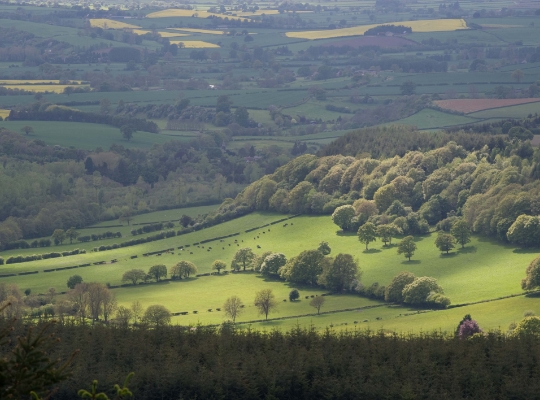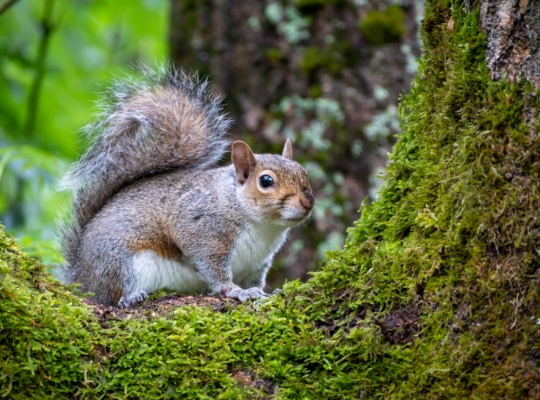All types of woodland are expected to be affected by the changing climate, with many impacts already evident.
Changes in temperature, precipitation, and risks such as wildfires, drought, storm damage and flooding will affect woodland biodiversity. An assessment of the level of risk from climate change is required, including woodlands managed for wildlife, close to nature woodlands, and ancient and semi-natural woodlands. Managers should consider what adaptation measures might be suitable to protect habitats and the species they support.
The rate of climate change is unprecedented. All types of woodland are expected to be affected by the changing climate. Impacts are already evident, with an increase in drought, wildfire, windthrow and pests and diseases expected to continue, which will threaten woodland habitats and the species they support.
Changes in temperature and precipitation amounts and seasonal patterns can have a strong impact on species populations and on ecological communities, and thus on biodiversity. For example, increased temperature (particularly in spring) will cause changes in phenology that may affect whole population networks.
It is well documented that bud burst and leaf flushing are occurring earlier in the season for many (but not all) tree species, which may affect the insect species that feed on these new leaves, such as larvae of particular moths and butterflies, which in turn may affect those species higher in the food chain for which these are food sources. Earlier tree canopy cover may also affect ground plant species growth and survival.
There may therefore be changes in the degree of synchrony between the lifecycle of different organisms, but the extent of this will vary greatly between different ecological networks, locations and populations. Another example is that changing rainfall patterns and warmer, drier summers will affect insect populations and survival (some positively, some negatively), and these will impact the insect-eating vertebrates that rely on these – again, varying greatly in different systems.
Recent evidence of changes and discussion of possible impacts on biodiversity are described in more detail in the LWEC biodiversity report card.

The changing climate is impacting ancient and semi-natural woodlands, and other woodlands where tree species change is more likely to occur naturally, rather than by planting decisions. The main impacts are changes in the location of particular habitats or species, in the vegetation composition, the tree age distribution and the woodland structure. For example, species adapted for cooler conditions may alter their range to higher elevations, or cooler aspects and microclimates. Conversely, species previously associated with warmer locations and at the northern or upper edge of their temperature range may start to colonise new locations, (as already evident for some more mobile species, such as insects and birds).
Changes in tree species composition are likely across all woodland types. Species that require warmer conditions may set seed more often and may regenerate where they previously did not (e.g. small-leaved lime and hornbeam). Other species that have substantial chilling requirements may have poorer germination and/or delayed bud burst after the milder winters.
The age structure of stands will be affected if there is an increased frequency of natural disturbance events, such as increased mortality from longer droughts, increased wildfire in fire-prone drier habitats, or more wind damage to stands on wetter soils in winter.
Changes in the vegetation community structure are particularly likely because of altered plant competition caused by changes in light from increased leaf area and earlier leafing, increases in the growing season temperature, and drier soil conditions in many woodland types during the summer months.
Woodland owners and managers should assess the level of risks that climate change poses and implement adaptation measures to build resilience.
Land management can reduce the risks to biodiversity from the changing climate. Protected sites are an important component which support species expanding northwards and enable species to maintain their southern range. Furthermore, connectivity at landscape scale can also contribute to building resilience for populations of species associated with woodland habitats; larger areas can increase resilience to extreme events.
Where priority is given to Biodiversity Action Plan (BAP) habitats, refer to The Climate Change Adaptation Manual (Natural England and the RSPB, 2020), which describes the potential sensitivity of a range of habitat types, including the main woodland habitats. Details about UK BAP Priority Habitats Conservation, including woodland, are available through the Joint Nature Conservation Committee.
For practical guidance on how to get started, visit the take action page.

The UKFS Practice Guide ‘Adapting forest and woodland management to the changing climate’ guides practitioners through the process from assessing climate change risks to implementing adaptation measures.
Printed copies are available to purchase from Forest Research.
Printed copies are available to purchase from Forest Research.
"*" indicates required fields
